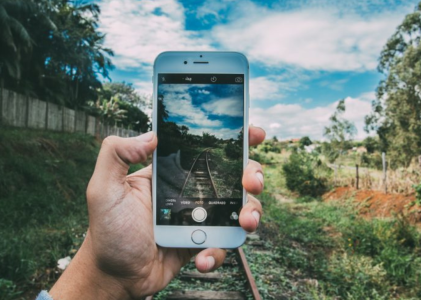A picture in Bangladesh. Like in the romantic painting Wanderer above the Sea of Fog, one Rohingya boy stands on a hillock above the bamboo and tarpaulin shelters and dirt paths of a refugee camp. The kid, dressed with the traditional longyi, points to the mountains on the horizon where his native Myanmar lies. This photograph was shot by Abul Kalam, one of the Rohingya photographers who use their smartphone cameras to document life in the camps.
The pictures of these photographers show the reality in the camps, including the banners held by refugees when they protest for their rights, and reach a worldwide audience on social media with hashtags like #RohingyaCrisis, #RohingyaLivesMatter, #Genocide and #EducationForAll.
A child from shalbagan after arrived in BD from burma, seeing our native land from here, admired different nature of Arakan, still can't forget the terrible situation moreover, eager to return to homeland with dignity if get fulfiled rights as per demand. Photo by A kalam.2018 pic.twitter.com/fYr0ePCFZj
— Abul kalam photography in Bangladesh (@kalamabul408) September 27, 2022
Nearly one million Rohingya Muslims live in large and precarious refugee camps in Bangladesh, where they lack proper access to education, healthcare, sanitation and the internet, They have suffered decades of discrimination and persecution in Myanmar, including the 2016 and 2017 military operations described as genocide by the United States and others. The situation and prospects of the Rohingya refugees are uncertain.
ICT for development (ICT4D)
The use of Information and Communication Technology (ICT) for Development, known as ICT4D, has been studied for decades by scholars such as Richard Heeks. ICT4D, a term in circulation since at least 1996, is the application of computers, phones, the internet and other technologies to promote development and human rights.
Mobile photography by Rohingya refugees is an example of ICT4D. Their pictures, capturing scenes of children playing or studying, people praying, working and even protesting, reach a global audience through social media platforms such as Facebook, Instagram and Twitter.
#Photography is an art of love. Draw by your eyes. Feel into the art by your heart.
Paint this art by colour of #education . Make an art of hope and future.#EducationForAll #Hope #Children #Rohingya #RohingyaCrisis pic.twitter.com/F8JJFV7iyn— Shahida Win (@ShahidaWin2) May 31, 2022
One could think that photography is not very useful for people who are struggling for their survival, but a smartphone with camera and social media are effective tools to advocate for their rights and enhance a sense of community and solidarity.
Buying a smartphone or connecting to the internet in the camps is difficult. Even though there are some small businesses, most refugees survive thanks to the charity provided by the UN and some NGOs. Being stateless, they cannot buy SIM cards in Bangladesh and need to find ways to get them illegally. Moreover, the refugees had to face an internet blackout imposed by the Bangladesh authorities for almost one year between 2019 and 2020.
In 2017, some Rohingya people took pictures and videos of the violence committed by the military and Buddhist militants and the exodus to Bangladesh. Sharing those videos and photos on social media, they called the attention of the international press. Even today in Myanmar´s Rakhine state, Rohingya Muslims are sharing videos of military attacks against their village in the middle of the conflict between the Myanmar Army and the Arakan Army guerrilla.
Rohingya villagers from Gudam Fara, Thayet Taung hamlet, #Buthidaung are fleeing as the clashes between #Myanmar Military and #Rakhine's Arakan Army intensified on Sep. 25.
There's neither safety nor protection for the remaining #Rohingya population in the ongoing #genocide. pic.twitter.com/8xSaAxAuAa
— The Rohingya Post (@TheRohingyaPost) September 25, 2022
A magazine by Rohingya photographers
Sahat Zia Hero, a Rohingya born in 1994 in Rakhine state, was studying Physics at Sittwe University but his studies were interrupted because of the discrimination against his community. He had to flee Myanmar in 2017 and now lives in a refugee camp in Bangladesh. In 2022 Sahat Zia Hero founded Rohingyatographer Magazine, a platform for Rohingya photographers.
From 1 to 14 September 2022, around 50 pictures by Rohingya photographers were showcased at the Cox´s Bazar Cultural Center in Bangladesh. The exhibit can still be visited virtually on the Rohingyatographer Magazine website. Besides, three Rohingya refugees, Omal Khair, Dil Kayas and Azimul Hasson, have shared their photos in the book A Chance to Breathe, published by PhotoEvidence. Another publication of Rohingya photographers is Rohingya Photography Competition.
The work of these photographers speaks of grief and loss, but also of dreams and hope, even within the dire situation of the refugee camps. As the writer and poet Seamus Heaney said, paraphrasing Vaclav Havel, “Hope is not optimism, which expects things to turn out well, but something rooted in the conviction that there is good worth working for.”
(Photo on the post´s entry and header by Markus Spiske via pexels.com)

